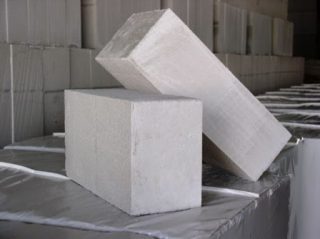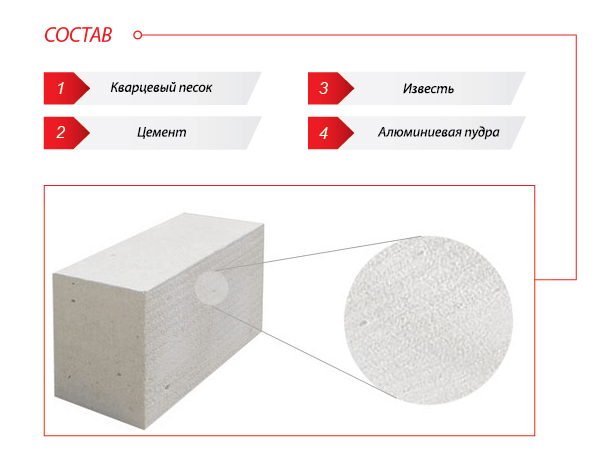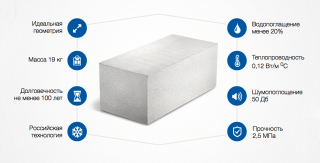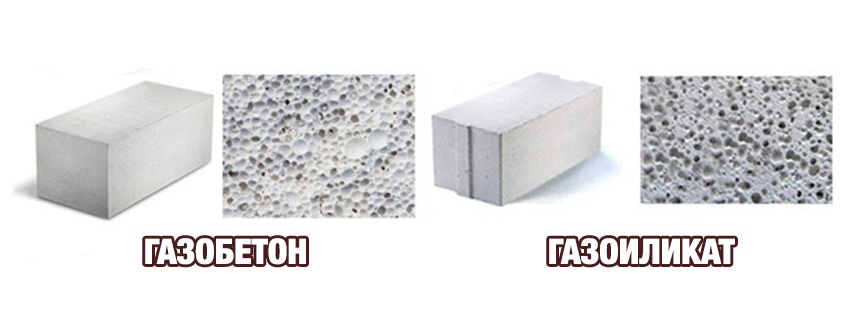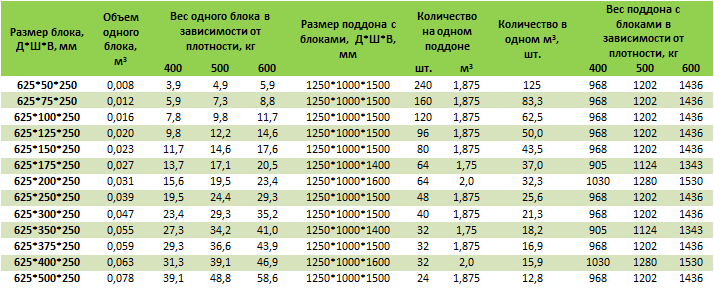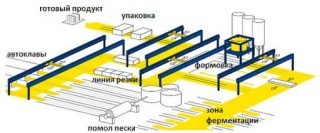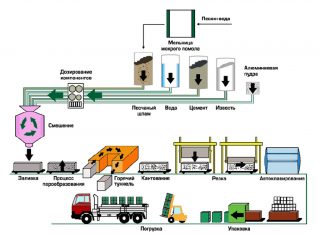In the field of low-rise construction, gas silicate blocks have become popular. Due to its porous structure, the material provides excellent energy efficiency to the building. Lightweight blocks with clear geometry allow you to quickly erect walls and partitions, reducing construction time. In order for the house to be durable and reliable, it is necessary to correctly choose gas silicate, take into account its characteristics and disadvantages.
Material features
Unlike other aerated concrete (foam concrete, aerated concrete) basis silicate aerated concrete block is lime with silica additives, not Portland cement. The component allows you to achieve a fine-mesh structure with a uniform distribution of pores. A change in the proportion of air cells in the total mass of products affects their density and technical characteristics.
Large percentage of pores reduces the strength of products, but increases their thermal insulation properties. Density blocks up to 500 kg / m³ are used for insulating load-bearing structures, in low-rise construction, in the construction of garages and outbuildings. If the density of the gas silicate reaches 700 kg / m³, it is used in the construction of high-rise buildings.
- thermal conductivity - 0.14 W / m * C;
- vapor permeability - 0.17-0.3;
- frost resistance - 25-100 cycles;
- density - D200-D700;
- water absorption - 25-30%.
The service life of gas silicate is more than 50 years... The standard block size allows you to make an accurate preliminary calculation of the required material and adhesive mixture. It is worth considering the fragility of products and the possibility of damage during transportation and unloading.
Differences from aerated concrete
Gas silicate and aerated concrete blocks are types of cellular concrete. They are united similar characteristics:
- porous structure;
- light weight;
- low thermal conductivity.
The difference between the blocks is noticeable in the composition and manufacturing technology. Gas silicate is based on a mixture of lime and silica additives... Also used in its production sand, water and aluminum powder... The amount of cement in the mixture is minimal or completely absent. Aerated concrete distinguished by high Portland cement content (up to 70%) the rest of the ingredients of the materials are similar. Blocks are easy to distinguish by color:
- aerated concrete - gray;
- gas silicate - white.
Aerated concrete production is carried out in two ways: autoclave and non-autoclave. Aerated concrete can be made by any of them, and gas silicate requires mandatory processing with steam under pressure in an autoclave... In terms of thermal insulation characteristics, resistance to compression and freezing, silicate concrete surpasses its analogue with a cement-sand base. Also, its advantages include a clear geometry of the blocks; when laying, thin seams are obtained that minimize heat loss.
Advantages and disadvantages of gas silicate blocks
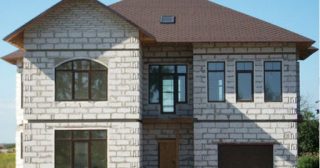
Porous blocks are widely used in construction due to the complex merits:
- Heat loss coefficient is 0.1-0.16 W / m * C. A low indicator provides the structure of the material - the presence of air pores inside.
- The porous structure allows dampen sound wavespreventing noise from entering the room.
- Favorable microclimate - aerated concrete is a vapor-permeable building material, which allows you to naturally regulate the level of humidity in the house. In its production, no harmful components are used; in terms of environmental safety, gas silicate is comparable to wood.
- Product dimensions (600x250x150-500) allow the building to be erected at an accelerated pace. The correct geometric shape reduces the fitting time, the size of the seams. The material is easily processed, it can be cut with a hacksaw, which allows the use of products in the construction of structures of complex shapes.
- Weight products depends on the density and size, the minimum indicator is 5 kg, the maximum is 40 kg. Gas block weighs almost 3 times less than a brickoccupying the same volume.
- Material, depending on the density, can be used for construction low-rise and high-rise buildings.
- Aerated concrete does not ignite when exposed to open fire, able to withstand temperatures up to 400 ° C without damage.
One of the most important points when choosing a material for building a house is its cost. Gas silicate is affordable, its use allows you to reduce the cost of wall insulation and foundation construction.
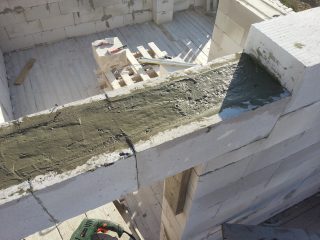
disadvantages gas silicate blocks:
- The porosity of concrete leads to active water absorption... Excessive moisture reduces its strength, promotes the spread of fungi and mold on the surface of the blocks. Exterior and interior decoration is required to prevent problems.
- Walls can sag over timewhich will cause cracking. It is important to correctly select and mount the foundation of the house.
- The blocks are not designed for uneven loading, they can break when bending... When transporting and laying, take into account the insufficient mechanical strength of the material. There are also difficulties with fixing fasteners on the walls... The cellular structure of concrete does not allow the use of conventional dowels. If it is necessary to place hanging furniture, facade decoration and other items, it is recommended to use special dowels with a grooved (grooved) surface that evenly distributes the load.
- When finishing, builders are faced with inability to use inexpensive cement-sand composition due to poor adhesion to walls. You need to plaster the house with special gypsum-based mixtures.
The material is not always to blame for the appearance of cracks. The accumulation of moisture, followed by freezing and cracking, provokes violation of construction technologybut. Blocks on the site and during the construction of walls are saturated with excess moisture. If, immediately after the end of the construction, finishing work is carried out using vapor-proof materials and solutions, the water is locked inside. At negative temperatures, it turns into ice and breaks the gas silicate.
Varieties of gas silicate blocks
Products are classified according to several parameters:
Appointment
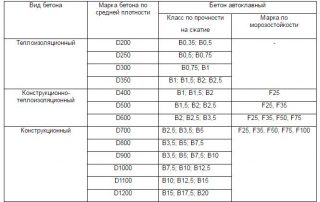
The scope of application of the material depends on the density and compressive strength:
- D1000-1200 kg / m³ - structural, designed for high load;
- D500-900 kg / m³ - structural and thermal insulation are widely used for masonry walls;
- D200-500 kg / m³ - heat-insulating ones are used for thermal insulation of structures, construction of one-story buildings.
Products differ significantly in terms of thermal insulation and strength. The increase in density is proportional to the reliability of the blocks, but the ability to retain heat decreases.
Product type
By configuration and design features, there are several types of blocks:
- straight line with flat edges;
- straight with recesses for gripping for hands;
- tongue-and-groove - has a groove-comb locking system;
- U-shaped - a block for lintels and the creation of reinforced belts;
- partition wall - products of reduced thickness.
Gas silicate with a tongue-and-groove system is more expensive than conventional wall blocks. The effectiveness of the lock is not great, therefore, such products can be abandoned with a limited budget.
Dimensions and weight
The parameters of building materials are regulated by GOST, products are produced in several standard sizes. Them maximum dimensions: 625x500x500 mm... Manufacturers offer blocks for walls:
- length - 600, 625 mm;
- width - 200-500 mm with a step of 50 mm;
- height - 200, 250, 300 mm.
Partition blocks with a standard height and length, they have a halved width indicator - 100-150 mm. U-shaped products are shorter than wall products, their length is 500 mm.
Gas silicate weight depends on the size and grade of density, the minimum is 5 kg, the maximum is 40 kg. According to GOST standards, products may have dimensional deviations: length up to 3 mm, width - 2 mm, height - 1 mm. The precise geometry allows the blocks to be laid on a thin layer of adhesive.
Composition and technology of production of building materials
- quicklime;
- quartz sand;
- Portland cement;
- gypsum;
- aluminum powder;
- ash or slag with a high content of calcium and magnesium silicates;
- water.
At the preparatory stage the sand is sieved and crushed to a fractional state close to the size of the powdery constituents. Lime also goes through a crushing procedure. Aluminum powder, which is a source of gassing, is moistened with water to obtain a suspension. Depending on the proportional ratio of the ingredients, blocks of different density are obtained.
- Components (sand, lime, Portland cement, gypsum, water) nare mixed 2-5 minutes until smooth.
- Into the mixer suspension is introduced aluminum powder to start the gassing process. The temperature of the aerated concrete solution is 40-45 ° C.
- Next stage - molding... The mixture is poured into molds treated with a lubricant. In them, the solution swells, reaching the calculated volume. Gassing occurs as a result of the reaction of aluminum and an aqueous solution of lime. A large amount of hydrogen is released, providing the porous structure of the material. After swelling, the product is left for 3-4 hours for ripening.
- Monolithic gas silicate is fed to the cutting area... The work is carried out with the help of special strings that cut the massif horizontally and vertically. If necessary, a groove-ridge lock is formed at the ends of the products. The accuracy of the geometric shape and size of the blocks depends on the accuracy of the work.
- The sliced array is placed in autoclaves, where steam treatment takes place at a temperature of 180-200 ° C at a pressure of 12 atmospheres. The duration of the procedure is 12-14 hours.
- After heat and humidity treatment, the products are loaded on wooden pallets... Shrink wrap is used as packaging to protect it from damage during transportation and moisture.
Products are stored in stacks on a flat area with the obligatory use of pallets. In the case of self-production of gas silicate blocks, autoclaving is often replaced by a set of strength in vivo for 15-30 days. The resulting products are lower in cost, but their strength does not correspond to GOST.
Criterias of choice
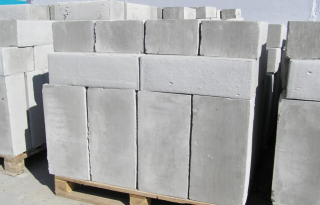
Before buying a building material, you must decide on its purpose... Low density products (d300-500) for wall insulation, construction of low-rise buildings, outbuildings and garages. High density blocks can be used for the construction of high-rise buildings. The thickness of the products directly affects the level of thermal protection. Bearing walls should be built of gas silicate 375-400 mm, self-supporting - from 300 mm, and for partitions, 100-150 mm is enough.
Factory made gas silicate blocks are of high quality. Mainly products are offered 1 grade with minimal deviations in geometry and the number of chips no more than 5%. In products 2 varieties 10% battle is allowed, but they will cost less and can be used for walls with subsequent cladding. Blocks must have marking including information:
- grade;
- density;
- compressive strength;
- sizes;
- frost resistance.


